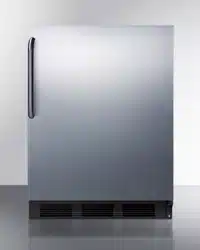Loading ...
Loading ...
Loading ...

8
Preparation and Setup
A B
CAUTION
To reduce risk of fire and to properly exhaust air, duct air
outside the house or building. Do not vent air into wall
spaces, ceilings, attics, crawlspaces, or garages.
• Local building codes may require use of makeup air sys-
tems with ventilation systems that move air at greater than
the specified rate (CFM), which rates depend on locale.
When designing the system, consult an HVAC specialist
for local requirements and to ensure optimal performance.
• All ductwork material (incl. screws and foil tape) must be
purchased separately by the customer.
• Ductwork must not interfere with floor joists or wall studs.
• On dual-exhaust models, the two 8” exhausts may be
merged into one 10” duct using Dacor transition kit
AHT10. See page 14 for details.
• Fasten all joints with sheet-metal screws, and seal with
certified duct/foil tape.
WARNING
During duct installation, ensure the damper flaps on top
of the hood can open freely.
Planning the Ductwork
WARNING
• To keep combustion byproducts, smoke, or odors out of the
home, and to improve efficiency, tape all duct joints securely.
• Range hoods may impede flow of smoke and combustion gases
from furnaces, gas waterheaters, and fireplaces. To avoid draw
-
ing lethal gases into the home, follow manufacturer directions
for these devices and NFPA/ASHRAE recommendations.
• Failure to install a remote blower or proper ductwork may
cause a backdraft and insufficient venting of smoke/fumes.
• DO NOT add an in-line or external blower to lengthen the
duct. Even small differences between blower air-flow rates
can greatly reduce the hood’s air draw.
Duct-Length Calculation Table
The type of duct determines the hood’s maximum straight
duct length.
Duct Type Maximum Duct Run
8-inch Round 60 feet
10-inch Round 50 feet
3 1/4-in x 10-in Rectangular 50 feet
For each new elbow and transition, subtract “equivalent
lengths” from the total maximum duct run to compensate
for wind resistance.
To determine your maximum length, start with the your duct
run’s total max. length, then subtract all of the ductwork
equivalent lengths. (See the chart.)
Ductwork Equivalent Lengths
Piece Subtract
8” 90° Elbow 7 feet
8” 45° Elbow 3 feet
10” 90° Elbow 5 feet
10” 45° Elbow 2 feet
3” x 10” to Round 90° Transition 25 feet
3¼” x 10” to 8”/10” Round Transition 4 feet
Wall Cap w/Damper
*
Roof Cap
*Equivalent lengths of roof and wall caps vary with model and configuration.
Ductwork Tips
• Minimize transitions, turns, and sharp angles (ex: two stag-
gered 45° angles are better than one sharp 90° angle).
• Keep turns as far away from the hood exhaust as pos-
sible; keep as much space between bends as possible.
• For best performance, use round instead of rectangular
ducting, especially when elbows are needed.
• If multiple elbows are used, try to keep at least 24 inches
of straight duct between each elbow.
• Do not use “S” or back-to-back adjacent elbows.
• In very cold-weather regions, use thermal breaks (i.e.,
short sections of non-metallic duct) to avoid indoor heat
loss. Put the break as close to the outside wall as possible.
• Do not use flexible metal ducting, or ductwork smaller
than what the tables advise.
• The hood exhaust connects to an 8” round duct. You can
increase the duct size over the duct run if desired.
• Never reduce duct size over the run. If existing ductwork
is under 8 inches in diameter, replace it with 8” ductwork.
• Always xonnect all duct sections with sheet-metal screws,
then seal joints with certified duct/foil tape.
Typically, the blower vents through hood top (A, above);
however, the blower can be rotated to vent through the
hood rear (B). When planning ductwork, always find the
shortest, most direct route to the outside.
Loading ...
Loading ...
Loading ...
